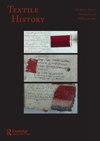Dressing Up: The Women Who Influenced French Fashion
IF 0.1
2区 社会学
0 HUMANITIES, MULTIDISCIPLINARY
引用次数: 0
Abstract
In Gilded Age America—where an estimated seventy-one per cent of private wealth was concentrated in the hands of the nine per cent—fashion was both an economic and social engine. Expensive laundry was a form of money laundering: converting sometimes dubiously obtained cash into cultural capital in the form of French fashion. Dressing Up explores the ‘soft diplomacy’ that women of the New World exercised by buying dresses from the Old World—along with art, interior decor and, occasionally, husbands. French garments and ‘fancy articles’ were available in the US as early as the 1840s, imported by local dressmakers who made regular trips to Paris. By the 1880s, thanks to improvements in international travel and communication, American women who could afford it were doing their shopping in Paris, though they continued to patronise stateside dressmakers and department stores. ‘Proxy shopping’ for hometown friends and family was a timeconsuming part of this fashion tourism. Paris was the home of haute couture: luxury fashion custom-made for elite clients. (The French term for ready-to-wear clothing was not couture but confection.) The history of haute couture has foregrounded the virtuosity of the designer, who was often (though not always) male—a narrative that Charles Frederick Worth has, rather unfairly, dominated. Block argues, persuasively, that female clients were ‘active participants in the large, transnational fashion system’—and that American women played a key role in shaping ‘French’ style. Along with their innate good taste, good looks and deep pockets, they brought their ‘entrenched frugality’—a holdover from Puritan provincialism—and ‘high textile I.Q.’ to bear on Gallic genius. Block explores the role of international expositions, which were places to preview the latest in taste and technology, and to see and be seen: visitors dressed to impress. Yet these costly gambits could bring financial ruin as well as good publicity to the fashion dealers who exhibited their wares. Lavish fancy dress balls functioned as extensions of the operas that usually preceded these late-night affairs; costumed guests strutted in vast, empty ballrooms like actors on a stage. These important fashion activations have been covered elsewhere, but Block fleshes out the story, introducing lesserknown names like Madame Olympe, Morin-Blossier (who dressed Princess Alexandra) and Maison F elix, the presumed designer of the black gown worn by John Singer Sargent’sMadame X. Most impressively, Block untangles the fascinating ties between couturiers and coiffeurs, milliners and perfumers. Both hair and dresses were routinely scented, and fashion magazines often identified the perfume as well as the dressmaker, hairdresser and corset-maker responsible for an outfit in a fashion plate. French hair salons advertised ‘American comfort’ and ‘American’ shampoo—that is, shampoo used with water, as opposed to French dry shampoo. Tantalising references to professional hair colouring and ‘the enormous international trade in human hair’ deserve further exploration. As in the eighteenth century, a ‘coiffure’ was a portable commodity rather than an ephemeral fashion statement. Similarly, the reuse of elite dress and lace has deeper roots; only in recent memory has it been taboo to wear a dress more than once, and modern royals and celebrities are pushing back on this for reasons of sustainability. Without sacrificing precision, the book would have benefited from framing these trends in a broader historical context. Though numerous and high quality, the illustrations in Dressing Up ultimately disappoint. The book includes front and back views of several surviving gowns, often alongside portraits or photos in《打扮:影响法国时尚的女性》
在镀金时代的美国——估计71%的私人财富集中在9%的富人手中——时尚既是经济的引擎,也是社会的引擎。昂贵的洗衣店是一种洗钱形式:将有时来路不明的现金转换成法国时尚形式的文化资本。《穿衣打扮》探索了新世界女性从旧世界购买服装、艺术品、室内装饰,偶尔还会购买丈夫的“软外交”。早在19世纪40年代,美国就可以买到法国服装和“高档物品”,它们是由定期前往巴黎的当地裁缝进口的。到19世纪80年代,由于国际旅行和通讯的发展,能够负担得起的美国女性在巴黎购物,尽管她们继续光顾美国本土的裁缝店和百货公司。为家乡的朋友和家人“代购”是这种时尚旅游中耗时的一部分。巴黎是高级时装的故乡:为精英客户定制的奢侈时装。(法语中成衣的叫法不是高级定制,而是糖果。)高级定制时装的历史凸显了设计师的精湛技艺,他们通常(尽管不总是)是男性——查尔斯·弗雷德里克·沃斯(Charles Frederick Worth)一直不公平地主导着这一叙事。布洛克令人信服地指出,女性客户是“庞大的跨国时尚体系的积极参与者”,而美国女性在塑造“法国”风格方面发挥了关键作用。除了天生的好品味、漂亮的外表和雄厚的财力外,他们还把“根深蒂固的节俭”(这是清教徒保守主义的遗风)和“高纺织智商”带到了高卢天才身上。布洛克探讨了国际博览会的作用,它是预览最新品味和技术的地方,也是看到和被看到的地方:游客的穿着给人留下深刻印象。然而,这些代价高昂的策略可能会给展出其产品的时装经销商带来财务损失和良好的宣传。奢华的化装舞会是通常在这些深夜活动之前的歌剧的延伸;盛装的宾客在空旷的宴会厅里昂首阔步,就像舞台上的演员。这些重要的时尚活动已经在其他地方被报道过,但布洛克充实了这个故事,介绍了一些不太为人所知的名字,比如奥林普夫人、莫林-布洛西耶(为亚历山德拉公主设计服装的人),以及约翰·辛格·萨金特(John Singer Sargent)饰演的x夫人所穿的黑色礼服的设计师Maison felix。最令人印象深刻的是,布洛克解开了女装设计师和理发师、女帽商和香水师之间的奇妙联系。头发和衣服都经常有香味,时尚杂志经常在时尚盘子里识别香水以及负责服装的裁缝、美发师和紧身胸衣制造商。法国发廊宣传的是“美式舒适”和“美式”洗发水——也就是加了水的洗发水,而不是法国的干式洗发水。有关专业染发和“巨大的人类头发国际贸易”的诱人说法值得进一步探索。在18世纪,“发型”是一种可携带的商品,而不是短暂的时尚宣言。同样,精英服饰和蕾丝的再利用有着更深的根源;直到最近,一件衣服不能穿一次以上才成为禁忌,而现代王室成员和名人出于可持续性的考虑,正在抵制这一禁忌。在不牺牲准确性的前提下,这本书将受益于在更广泛的历史背景下构建这些趋势。尽管《装扮》中的插图数量众多,质量也很高,但最终还是让人失望。这本书包括了几件幸存的礼服的正面和背面,通常还附有她的肖像或照片
本文章由计算机程序翻译,如有差异,请以英文原文为准。
求助全文
约1分钟内获得全文
求助全文
来源期刊

TEXTILE HISTORY
HUMANITIES, MULTIDISCIPLINARY-
CiteScore
1.00
自引率
0.00%
发文量
0
期刊介绍:
Textile History is an internationally recognised, peer reviewed journal and one of the leading publications in its field. It is viewed as an important outlet for current research. Published in the spring and autumn of each year, its remit has always been to facilitate the publication of high-quality research and discussion in all aspects of scholarship arising from the history of textiles and dress. Since its foundation the scope of the journal has been substantially expanded to include articles dealing with aspects of the cultural and social history of apparel and textiles, as well as issues arising from the exhibition, preservation and interpretation of historic textiles or clothing.
 求助内容:
求助内容: 应助结果提醒方式:
应助结果提醒方式:


